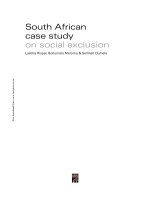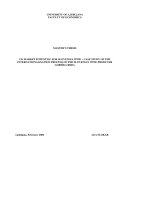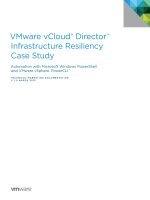Case study cancer risk assessment dec 12 compatibility mode
Bạn đang xem bản rút gọn của tài liệu. Xem và tải ngay bản đầy đủ của tài liệu tại đây (427.38 KB, 7 trang )
12/8/2010
1
Alachlor
C
2
H
5
N
CH CHO
3
2
CO CH
2
Cl
C
2
H
5
2
Alachlor is a herbicide used for weed control on
corn, soybeans, sorghum, peanuts, and beans
Physiochemical Properties
Chemical Name: 2-chloro-N-(2,6
diethylphenyl)-N-
(methoxymethyl) acetamide
Common Names: The common name alachlor
is in general use
Chemical Family: Acetanilide
Colour: Colourless to white crystalline
Physical State: Solid
Residue limits have been set for exposure to
alachlor through both food and water by a series
of laboratory exposure studies
Alachlor Exposure Toxicological Studies
Acute Toxicity
In studies using laboratory animals, alachlor
generally has been shown to be of low acute
toxicity. All studies have been classified as either
Category III or IV, the two lowest classifications
Category
III
or
IV,
the
two
lowest
classifications
¾ Acute oral toxicity in rats LD
50
= 930 mg/kg
¾ Acute dermal toxicity in rats LD
50
= 13.3 g/kg
¾ Acute inhalation toxicity in rats LC
50
> 1.04 mg/L
(4 hours)
12/8/2010
2
Subchronic Toxicity
In an oral toxicity study conducted in rats, they were
administered doses of 0, 1.5, 15, or 146 mg/kg/day for a
period of 90 days
¾ Systemic toxicity was noted in high dose animals as decreased
body weights and body weight gains, decreased food consumption
and efficiency, along with other symptoms of toxicity
¾ The NOEL was determined to be 15 mg/kg/day
Another oral toxicity study was conducted in dogs that were
administered alachlor in doses of 0, 5, 25, 50, or 75
mg/kg/day for 6 months
¾ There were signs of toxicity at all dose levels including the lowest
dose level where an increase in liver weights was noted in males
¾ The NOEL could not be determined, however the LOEL
was 5
mg/kg/day
Chronic Toxicity
In a one-year oral toxicity study conducted in dogs,
alachlor was administered in doses of 0, 1.0, 3.0, or 10
mg/kg/day.
¾ Toxicity was noted at the 3 mg/kg/day dose as hemosiderosis in the
kidney and in the spleen of male dogs
¾ At the high dose toxicity was reported as hemosiderosis and
hemolytic anemia in the liver of males
hemolytic
anemia
in
the
liver
of
males
¾ The NOEL was determined to be 1 mg/kg/day
In a two-year oral toxicity study rats were administered
doses of 0, 14, 42, or 126 mg/kg/day for approximately 117
weeks in males and 106 weeks in females.
¾ Toxicity was noted at 14 mg/kg/day and above as ocular lesions
and as increased thyroid weights in both sexes, and as increased
liver weight in the high dose group
¾ The NOEL was determined to be less than 14 mg/kg/day
Chronic Toxicity
In a second long-term study, rats were fed doses
of 0, 0.5, 2.5, or 15 mg/kg/day of alachlor for 110
weeks.
¾ Toxicity was seen at the highest dose tested
as molting of retinal pigmentation and
as
molting
of
retinal
pigmentation
and
increased mortality in females, with
abnormal disseminated foci of the liver in
males
¾ The NOEL was determined to be 2.5
mg/kg/day
Carcinogenicity
In a carcinogenicity study conducted in mice, alachlor
stablized with epichlorohydrin was adminstered at the
start of the study for 11 months, and then with a lot
stabilized with epoxidized soybean oil was administered
in the diet of mice for 18 months
The doses administered were 0, 26, 78, or 260 mg/kg/day
¾ Thyroid follicular atrophy was noted in the mid and high dose
males and the high dose females
¾ Males and females had a significant increased trend in
bronchioaveolar adenomas
12/8/2010
3
Carcinogenicity
In a two-year carcinogenicity study conducted in rats, a dose of 126
mg/kg/day was administered in the diet for two years.
¾ It was observed that females were more sensitive than males
¾ Nasal, thyroid, and gastric tumors were observed
¾ The nasal tumors were noted after 2 years in a group that was
exposed to alachlor for only the first 5 to 6 months
¾
The NOEL was determined to be
0
5
mg/kg/day
¾
The
NOEL
was
determined
to
be
0
.
5
mg/kg/day
A second carcinogenicity study was conducted on mice receiving 0,
16.64, 65.42, or 262.4 mg/kg/day for males and 0, 23.73, 90.34, 399.22
mg/kg/day for females of alachlor over an 18 month period
¾ The mice showed evidence of bronchoalveolar adenomas and/or
carcinomas in the lung
¾ The NOEL was determined to be 16.64 mg/kg/day for males and
90.34 mg/kg/day for females
Developmental Toxicity
In a developmental toxicity study, rats were administered
0, 50,150, 400 mg/kg/day of alachlor by gavage on
gestation days 6 through 19, inclusive
¾ Toxicity was noted at the high dose as a slight increase in the
mean number of early and late resorptions with related increased
implantation loss and a slight reduction in the mean number of
viable fetuses
¾ The NOEL was determined to be 150 mg/kg/day
In a rabbit developmental toxicity study, they received
doses of 0, 50, 100, or 150 mg/kg/day of alachlor by gavage
on days 7 through 19, inclusive
¾ There were no signs of developmental toxicity noted in this study
at any dose level used
¾ The NOEL was determined to be equal to or greater than 150
mg/kg/day
Reproductive Toxicity
In a three-generation reproduction study, rats received
either 0, 3, 10, or 30 mg/kg/day of alachlor in the diet
¾ The high dose females of each parental
generation and the third generation females had
lower ovary weights
¾ No microsco
p
ic chan
g
es were re
p
orted in the
pg p
ovaries and no effect was noted on reproductive
parameters
¾ The parental/offspring NOEL was determined to be
10 mg/kg/day
Summary of Alachlor Study Results
NOELAlachlor Study
mg/kg/day
15(rats)Subchronic Toxicity
5.0*(dogs)
1.0(dogs)Chronic Toxicity/
< 14(rats)Carcinogenicity
* This is based on a LOEL, because no NOEL value was determined from the study
2.5(rats)
16.64males(mice)Carcinogenicity
90.34females
0.5(rats)
150(rats)Developmental Toxicity
>
150(rabbits)
10(rats)Reproductive
12/8/2010
4
Reference Dose for Alachlor
The NOEL in the chronic rat study of 0.5 mg/kg/day was
considered to be the appropriate endpoint for establishing
the non-cancer RfD for alachlor
An uncertainty factor of 100 was applied to account for
both the interspecies extrapolation and intraspecies
variability
variability
¾ RfD = 0.5 mg/kg/day = 0.005 mg/kg/day
100
On this basis the RfD was calculated to be 0.005
mg/kg/day
However
LED
10
for Alachlor
Th EPA d i
li i f
Since alachlor is classified as a “likely” human
carcinogen additional safety factors must be invoked
Th
e
EPA
agree
d
upon us
i
ng a non-
li
near marg
i
n o
f
exposure (MOE) approach for the purpose of risk
assessment of alachlor
Since there were rare tumors seen with alachlor exposure
in animal studies, for the purposes of risk assessment, the
MOE for the nasal tumors should be determined with 0.5
mg/kg/day as the “ point of departure” or LED
10
as no
tumor response was seen at this dose level
Margin of Exposure for Alachlor
MOE = LED
10
Human exposure of interest
Therefore for alachor
Therefore
,
for
alachor
MOE = 0.5 mg/kg/day
Human exposure of interest
With a margin of exposure (MOE) < 100 being
considered an unacceptable risk
Margin of Exposure for Alachlor using
the Non-Linear Model
Observed
Range
Extrapolation
Range
s
e
Confidence
Limit on
Dose
50%
Central
Estimate
Dose of Alachlor
MOE
Respon
s
0.5
Human
Exposure of
Interest for
Alachlor
ED
10
10%
0%
12/8/2010
5
Alachlor Residues in Food
The estimated maximum alachlor exposure from
food to the average person in the U.S. was
calculated as 0.000011 mg/kg bw/day
RfD = 0.005 mg/kg/day and the
TMDI = 0.000011 mg/kg bw/day
RfD >
TMDI, therefore the use is safe.
Alachlor Residue in Water
The estimated maximum alachlor exposure from
water to the average person in the U.S. was
calculated as 0.0000571 mg/kg bw/day
RfD = 0.005 mg/kg/day and the
TMDI = 0.0000571 mg/kg bw/day
RfD >
TMDI, therefore the use is safe.
Total Alachlor Residue Exposure
An aggregate exposure to alachlor can be calculated :
Total residue exposure = sum of residue from food
and water
= TMDI
food
+ TMDI
water
food
water
= 0.000011 + 0.0000571
= 0.0000681 mg/kg/day
RfD = 0.005 mg/kg/day
RfD >
∑ TMDI
Therefore, the use of alachlor is safe when considering
chronic exposure to the general population
Carcinogenic Food Residue Risk for Alachlor
(Using the MOE Approach)
The estimated maximum alachlor exposure
from food once again is 0.000011 mg/kg
bw/day
TMDI = 0.000011 mg/kg bw/day
Now, instead of comparing the TMDI to the
RfD, a margin of exposure must be calculated
for the food residue exposure
12/8/2010
6
Carcinogenic Food Residue Risk for Alachlor
(Using the MOE Approach)
For nasal tumors the LED
10
or the “point of departure” was
determined to be 0.5 mg/kg/day
Since the MOE
=
LED
10
/ human exposure of interest
Since
the
MOE
LED
10
/
human
exposure
of
interest
= LED
10
/ TMDI
food
= 0.5 / 0.000011
≈ 45000
Since the MOE is greater than 100, the use of alachlor is
safe meaning there is an acceptably low risk of cancer
from alachlor residue in food
Carcinogenic Drinking Water Residue
Risk for Alachlor (Using the MOE Approach)
The estimated maximum alachlor exposure from
drinking water once again is 0.0000571 mg/kg
bw/day
TMDI = 0.0000571 mg/kg bw/day
Just as for the food residue, instead of comparing
the TMDI to the RfD, a margin of exposure is
calculated for drinking water residue exposure
Carcinogenic Drinking Water Residue
Risk for Alachlor (Using the MOE Approach)
The LED
10
or the “point of departure” once again is 0.5
mg/kg/day
And the MOE = LED
10
/ human exposure of interest
=
LED
10
/TMDI
t
LED
10
/
TMDI
wa
t
er
= 0.5 / 0.0000571
≈ 8800
Since the MOE is greater than 100, the use of alachlor is safe
meaning there is an acceptably low risk of cancer from
alachlor residue in drinking water
Total Carcinogenic Residue Risk for
Alachlor (Using the MOE Approach)
An aggregate exposure to alachlor can be calculated :
Total residue exposure = sum of residue from food and water
= TMDI
food
+ TMDI
water
= 0.000011 + 0.0000571
= 0.0000681 mg/kg/day
Now, an aggregate carcinogenic risk can be calculated by
determining the MOE
12/8/2010
7
Total Carcinogenic Residue Risk for
Alachlor (Using the MOE Approach)
MOE = LED
10
/ total human exposure
= LED
10
/ TMDI
food
+ TMDI
water
= 0.5 / (0.000011 + 0.0000571)
≈ 7300
Since the MOE is greater than 100, the use of alachlor is safe
meaning there is an acceptably low risk of cancer from
chronic exposure to alachlor residue in the diet









